Acceleration Magnitude at Impact Following Loss of Balance Can Be Estimated Using Deep Learning Model
Abstract
1. Introduction
2. Materials and Methods
2.1. Application to Multi-Class Pre-Impact Fall Impact Accelerometer Magnitude Prediction Model
2.2. Data Collection
2.2.1. Apparatus
2.2.2. Subjects
2.2.3. Experimental Protocols
2.2.4. Data Collections and Processing
2.3. Feature Extraion from Raw Inertial Measurement Unit Signal
2.4. Data Augmentation
2.5. Deep Learning Network
2.5.1. A Bi-Directional Long Short-Term Memory
2.5.2. The Flow of the Impact Fall Prediction Model Using Deep Learning
2.6. Performance Measures
3. Results
4. Discussion
5. Conclusions
Author Contributions
Funding
Conflicts of Interest
References
- Choi, A.; Kang, T.G.; Mun, J.H. Biomechanical Evaluation of Dynamic Balance Control Ability During Golf Swing. J. Med. Biol. Eng. 2016, 36, 430–439. [Google Scholar] [CrossRef]
- Choi, A.; Sim, T.; Mun, J.H. Improved determination of dynamic balance using the centre of mass and centre of pressure inclination variables in a complete golf swing cycle. J. Sports Sci. 2015, 34, 906–914. [Google Scholar] [CrossRef] [PubMed]
- Hrysomallis, C. Relationship Between Balance Ability, Training and Sports Injury Risk. Sports Med. 2007, 37, 547–556. [Google Scholar] [CrossRef] [PubMed]
- Zecevic, A.A.; Salmoni, A.; Speechley, M.; Vandervoort, A.A. Defining a Fall and Reasons for Falling: Comparisons Among the Views of Seniors, Health Care Providers, and the Research Literature. Gerontologist 2006, 46, 367–376. [Google Scholar] [CrossRef] [PubMed]
- De La Concepción, M.A.A.; Morillo, L.M.S.; Álvarez-García, J.A.; González-Abril, L. Mobile activity recognition and fall detection system for elderly people using Ameva algorithm. Pervasive Mob. Comput. 2017, 34, 3–13. [Google Scholar] [CrossRef]
- Luque, R.; Casilari, E.; Morón, M.-J.; Redondo, G. Comparison and Characterization of Android-Based Fall Detection Systems. Sensors 2014, 14, 18543–18574. [Google Scholar] [CrossRef] [PubMed]
- Rubenstein, L.Z. Falls in older people: Epidemiology, risk factors and strategies for prevention. Age Ageing 2006, 35. [Google Scholar] [CrossRef]
- Prince, F.; Corriveau, H.; Hébert, R.; Winter, D.A. Gait in the elderly. Gait Posture 1997, 5, 128–135. [Google Scholar] [CrossRef]
- De Backere, F.; Ongenae, F.; Abeele, F.V.D.; Nelis, J.; Bonte, P.; Clément, E.; Philpott, M.; Hoebeke, J.; Verstichel, S.; Ackaert, A.; et al. Towards a social and context-aware multi-sensor fall detection and risk assessment platform. Comput. Biol. Med. 2015, 64, 307–320. [Google Scholar] [CrossRef]
- Choi, A.; Jung, H.; Mun, J.H. Single Inertial Sensor-Based Neural Networks to Estimate COM-COP Inclination Angle During Walking. Sensors 2019, 19, 2974. [Google Scholar] [CrossRef]
- Hu, X.; Qu, X. Pre-impact fall detection. Biomed. Eng. Online 2016, 15, 1–16. [Google Scholar] [CrossRef]
- Özdemir, A.T.; Barshan, B. Detecting Falls with Wearable Sensors Using Machine Learning Techniques. Sensors 2014, 14, 10691–10708. [Google Scholar] [CrossRef]
- Yu, X.; Qiu, H.; Xiong, S. A Novel Hybrid Deep Neural Network to Predict Pre-impact Fall for Older People Based on Wearable Inertial Sensors. Front. Bioeng. Biotechnol. 2020, 8, 8. [Google Scholar] [CrossRef]
- Mubashir, M.; Shao, L.; Seed, L. A survey on fall detection: Principles and approaches. Neurocomputing 2013, 100, 144–152. [Google Scholar] [CrossRef]
- Wu, Y.; Su, Y.; Feng, R.; Yu, N.; Zang, X. Wearable-sensor-based pre-impact fall detection system with a hierarchical classifier. Measurement 2019, 140, 283–292. [Google Scholar] [CrossRef]
- Noury, N.; Fleury, A.; Rumeau, P.; Bourke, A.K.; Laighin, G.O.; Rialle, V.; Lundy, J.E. Fall detection-principles and methods. In Proceedings of the 29th Annual International Conference of the IEEE Engineering in Medicine and Biology Society, Lyon, France, 22–26 August 2007; pp. 1663–1666. [Google Scholar]
- Arena, S.L.; Davis, J.L.; Grant, J.W.; Madigan, M.L. Tripping Elicits Earlier and Larger Deviations in Linear Head Acceleration Compared to Slipping. PLoS ONE 2016, 11, e0165670. [Google Scholar] [CrossRef] [PubMed]
- Groen, B.E.; Weerdesteyn, V.; Duysens, J. The relation between hip impact velocity and hip impact force differs between sideways fall techniques. J. Electromyogr. Kinesiol. 2008, 18, 228–234. [Google Scholar] [CrossRef]
- Hajiaghamemar, M.; Seidi, M.; Ferguson, J.R.; Caccese, V. Measurement of Head Impact Due to Standing Fall in Adults Using Anthropomorphic Test Dummies. Ann. Biomed. Eng. 2015, 43, 2143–2152. [Google Scholar] [CrossRef]
- Choi, W.J.; Wakeling, J.; Robinovitch, S.N. Kinematic analysis of video-captured falls experienced by older adults in long-term care. J. Biomech. 2015, 48, 911–920. [Google Scholar] [CrossRef] [PubMed]
- Kurt, M.; Laksari, K.; Kuo, C.; Grant, G.A.; Camarillo, D.B. Modeling and Optimization of Airbag Helmets for Preventing Head Injuries in Bicycling. Ann. Biomed. Eng. 2016, 45, 1148–1160. [Google Scholar] [CrossRef]
- Marconi, E.; Gatto, F.; Massaro, M. Investigation on Wearable Airbags for Motorcyclists Through Simulations and Experimental Tests. In The World Congress on Engineering; Springer: Singapore, 2018; pp. 87–100. [Google Scholar]
- Lee, J.K.; Robinovitch, S.N.; Park, E.J. Inertial Sensing-Based Pre-Impact Detection of Falls Involving Near-Fall Scenarios. IEEE Trans. Neural Syst. Rehabil. Eng. 2014, 23, 258–266. [Google Scholar] [CrossRef] [PubMed]
- Serpen, G.; Khan, R.H. Real-time Detection of Human Falls in Progress: Machine Learning Approach. Procedia Comput. Sci. 2018, 140, 238–247. [Google Scholar] [CrossRef]
- Emmatpour, M.; Ferrero, R.; Montrucchio, B.; Rebaudengo, M. A Review on Fall Prediction and Prevention System for Personal Devices: Evaluation and Experimental Results. Adv. Hum. Comput. Interact. 2019. [Google Scholar] [CrossRef]
- Lapierre, N.; Neubauer, N.; Miguel-Cruz, A.; Rincón, A.M.R.; Liu, L.; Rousseau, J. The state of knowledge on technologies and their use for fall detection: A scoping review. Int. J. Med. Inform. 2018, 111, 58–71. [Google Scholar] [CrossRef]
- Xu, T.; Zhou, Y.; Zhu, J. New Advances and Challenges of Fall Detection Systems: A Survey. Appl. Sci. 2018, 8, 418. [Google Scholar] [CrossRef]
- Liu, J.; Lockhart, T.E. Development and evaluation of a prior-to-impact fall event detection algorithm. IEEE Trans. Biomed. Eng. 2014, 61, 2135–2140. [Google Scholar] [CrossRef]
- Tamura, T.; Yoshimura, T.; Sekine, M.; Uchida, M.; Tanaka, O. A wearable airbag to prevent fall injuries. IEEE Trans. Inf. Technol. Biomed. 2009, 13, 910–914. [Google Scholar] [CrossRef]
- Casilari-Pérez, E.; García-Lagos, F. A comprehensive study on the use of artificial neural networks in wearable fall detection systems. Expert Syst. Appl. 2019, 138, 112811. [Google Scholar] [CrossRef]
- Sabatini, A.M.; Ligorio, G.; Mannini, A.; Genovese, V.; Pinna, L. Prior-to- and Post-Impact Fall Detection Using Inertial and Barometric Altimeter Measurements. IEEE Trans. Neural Syst. Rehabil. Eng. 2015, 24, 774–783. [Google Scholar] [CrossRef]
- Aziz, O.; Russell, C.M.; Park, E.J.; Robinovitch, S.N. The effect of window size and lead time on pre-impact fall detection accuracy using support vector machine analysis of waist mounted inertial sensor data. In Proceedings of the 36th Annual International Conference of the IEEE Engineering in Medicine and Biology Society, Chicago, IL, USA, 26–30 August 2014; pp. 30–33. [Google Scholar]
- Kim, T.H.; Choi, A.; Heo, H.M.; Kim, K.; Lee, K.; Mun, J.H. Machine Learning-Based Pre-Impact Fall Detection Model to Discriminate Various Types of Fall. J. Biomech. Eng. 2019, 141, 081010. [Google Scholar] [CrossRef]
- Kangas, M.; Vikman, I.; Wiklander, J.; Lindgren, P.; Nyberg, L.; Jämsä, T. Sensitivity and specificity of fall detection in people aged 40 years and over. Gait Posture 2009, 29, 571–574. [Google Scholar] [CrossRef] [PubMed]
- Pierleoni, P.; Belli, A.; Palma, L.; Pellegrini, M.; Pernini, L.; Valenti, S. A High Reliability Wearable Device for Elderly Fall Detection. IEEE Sens. J. 2015, 15, 4544–4553. [Google Scholar] [CrossRef]
- Choi, A.; Jung, H.; Kim, H.; Mun, J.H. Predicting Center of Gravity Displacement During Walking Using a Single Inertial Sensor and Deep Learning Technique. J. Med. Imaging Health Inform. 2020, 10, 1436–1443. [Google Scholar] [CrossRef]
- Nweke, H.F.; Teh, Y.W.; Al-Garadi, M.A.; Alo, U.R. Deep learning algorithms for human activity recognition using mobile and wearable sensor networks: State of the art and research challenges. Expert Syst. Appl. 2018, 105, 233–261. [Google Scholar] [CrossRef]
- Kamycki, K.; Kapuscinski, T.; Oszust, M. Data Augmentation with Suboptimal Warping for Time-Series Classification. Sensors 2019, 20, 98. [Google Scholar] [CrossRef]
- Wen, Q.; Sun, L.; Song, X.; Gao, J.; Wang, X.; Xu, H. Time Series Data Augmentation for Deep Learning: A Survey 2020. arXiv 2020, arXiv:2002.12478. [Google Scholar]
- Zhou, H.; Zhong, Z.; Hu, M. Design and Occupant-Protection Performance Analysis of a New Tubular Driver Airbag. Engineering 2018, 4, 291–297. [Google Scholar] [CrossRef]
- Shi, G.; Chan, C.S.; Li, W.J.; Leung, K.-S.; Zou, Y.; Jin, Y. Mobile Human Airbag System for Fall Protection Using MEMS Sensors and Embedded SVM Classifier. IEEE Sens. J. 2009, 9, 495–503. [Google Scholar] [CrossRef]
- Choi, A.; Jung, H.; Lee, K.Y.; Lee, S.; Mun, J.H. Machine learning approach to predict center of pressure trajectories in a complete gait cycle: A feedforward neural network vs. LSTM network. Med. Biol. Eng. Comput. 2019, 57, 2693–2703. [Google Scholar] [CrossRef]
- Eyobu, O.S.; Han, D.S. Feature Representation and Data Augmentation for Human Activity Classification Based on Wearable IMU Sensor Data Using a Deep LSTM Neural Network. Sensors 2018, 18, 2892. [Google Scholar] [CrossRef]
- Ronao, C.A.; Cho, S.-B. Human activity recognition with smartphone sensors using deep learning neural networks. Expert Syst. Appl. 2016, 59, 235–244. [Google Scholar] [CrossRef]
- Pascanu, P.; Mikolov, T.; Bengio, Y. On the difficulty of training recurrent neural networks. In Proceedings of the 30th International Conference on Machine Learning, Atlanta, GA, USA, 16–21 June 2013; pp. 1310–1318. [Google Scholar]
- Sagheer, A.; Kotb, M. Time series forecasting of petroleum production using deep LSTM recurrent networks. Neurocomputing 2019, 323, 203–213. [Google Scholar] [CrossRef]
- Li, X.; Peng, L.; Hu, Y.; Shao, J.; Chi, T. Deep learning architecture for air quality predictions. Environ. Sci. Pollut. Res. 2016, 23, 22408–22417. [Google Scholar] [CrossRef]
- Fukaya, K.; Uchida, M. Protection against impact with the ground using wearable airbags. Ind. Health 2008, 46, 59–65. [Google Scholar] [CrossRef]
- Sarvi, M.N.; Luo, Y. Sideways fall-induced impact force and its effect on hip fracture risk: A review. Osteoporos. Int. 2017, 28, 2759–2780. [Google Scholar] [CrossRef] [PubMed]
- Taylor, L.; Nitschke, G. Improving deep learning using generic data augmentation. arXiv 2017, arXiv:170806020. [Google Scholar]
- Rashid, K.M.; Louis, J. Times-series data augmentation and deep learning for construction equipment activity recognition. Adv. Eng. Inform. 2019, 42, 100944. [Google Scholar] [CrossRef]
- Hsieh, C.-Y.; Liu, K.-C.; Huang, C.-N.; Chu, W.-C.; Chan, C.-T. Novel Hierarchical Fall Detection Algorithm Using a Multiphase Fall Model. Sensors 2017, 17, 307. [Google Scholar] [CrossRef]
- Liu, C.; Jiang, Z.; Su, X.; Benzoni, S.; Maxwell, A. Detection of Human Fall Using Floor Vibration and Multi-Features Semi-Supervised SVM. Sensors 2019, 19, 3720. [Google Scholar] [CrossRef]
- Anglin, J.M.; Sugiyama, T.; Liew, S.-L. Visuomotor adaptation in head-mounted virtual reality versus conventional training. Sci. Rep. 2017, 7, 45469. [Google Scholar] [CrossRef]
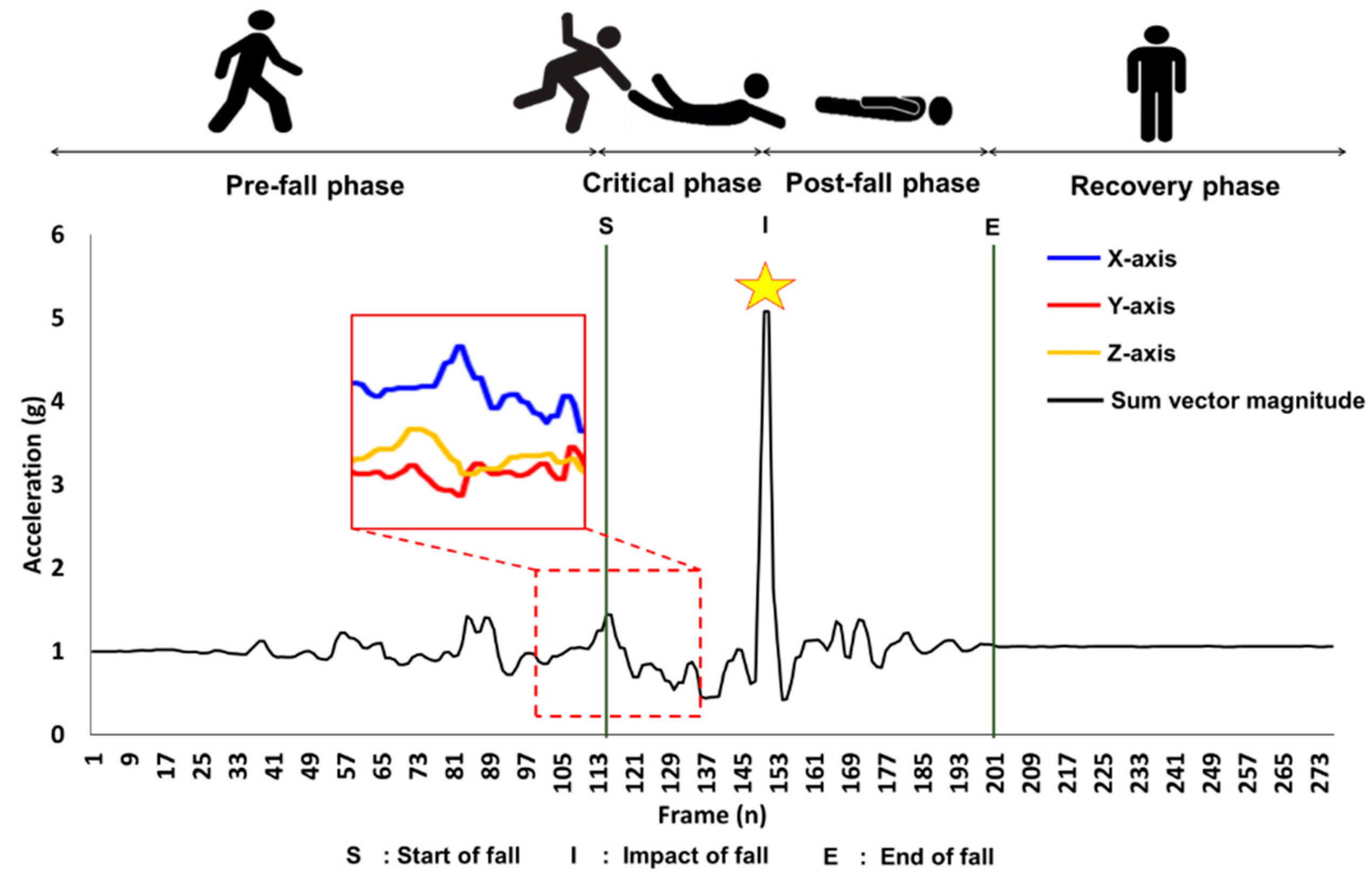
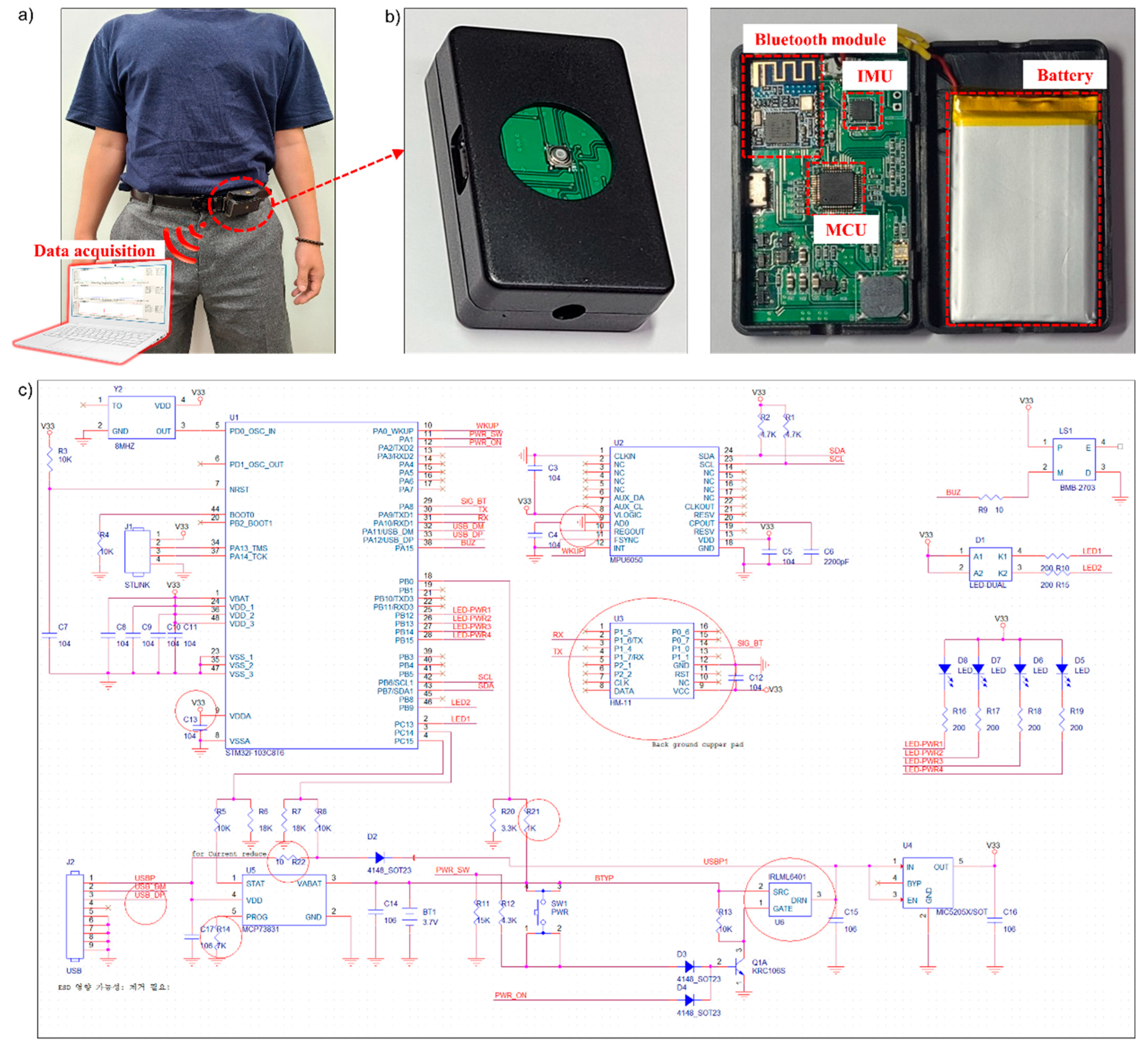




| Number | Feature Types |
|---|---|
| 1. | x-axis of raw accelerometer signal |
| 2. | y-axis of raw accelerometer signal |
| 3. | z-axis of raw accelerometer signal |
| 4. | Sum vector magnitude of accelerometer |
| 5. | Sum vector on horizontal plane of accelerometer |
| 6. | Root mean square of sum vector magnitude |
| 7. | x-axis of raw angular velocity signal |
| 8. | y-axis of raw angular velocity signal |
| 9. | z-axis of raw angular velocity signal |
| 10. | Resultant angular velocity |
| Bi-Directional Long Short-Term Memory Network Architecture Training Option | ||
|---|---|---|
| Number | Type of Parameters | Range of Parameters |
| 1. | Number of hidden units | [100, 50] |
| 2. | Maximum epochs | 125 |
| 3. | Mini-batch size | 64 |
| 4. | Weight initializer function | Glorot |
| 5. | Solver | Adam |
| 6. | Dropout rate | 0.2 |
| 7. | Initial learning rate | 0.01 |
| 8. | Gradient threshold | 2 |
| 9. | Gradient threshold method | Global-l2norm |
| 10. | L2Regularization | 1 × 10−5 |
| Front Fall | Back Fall | Left Fall | Right Fall | Straight Fall | |||||||
|---|---|---|---|---|---|---|---|---|---|---|---|
| MAPE | r | MAPE | r | MAPE | r | MAPE | r | MAPE | r | ||
| Raw | No-fold | 27.6 | 0.2 | 34.5 | 0.12 | 33.5 | 0.22 | 30.1 | 0.28 | 17.3 | 0.32 |
| 1-fold | 33.6 | 0.25 | 22.5 | 0.29 | 20.8 | 0.46 | 23.3 | 0.14 | 15.3 | 0.52 | |
| 2-fold | 29.6 | 0.28 | 18.2 | 0.33 | 16.6 | 0.33 | 17.3 | 0.21 | 14.7 | 0.51 | |
| 3-fold | 25.5 | 0.30 | 14.5 | 0.25 | 19.1 | 0.1 | 13.7 | 0.1 | 10.7 | 0.5 | |
| 4-fold | 22.8 | 0.35 | 12.5 | 0.55 | 12.4 | 0.32 | 10.7 | 0.24 | 6.9 | 0.60 | |
| Jittering | No-fold | 36.9 | 0.16 | 32.1 | 0.18 | 39.1 | 0.16 | 33.1 | 0.18 | 16.9 | 0.32 |
| 1-fold | 30.2 | 0.40 | 19.2 | 0.50 | 21.6 | 0.38 | 21.6 | 0.57 | 15.3 | 0.59 | |
| 2-fold | 30.3 | 0.50 | 16 | 0.65 | 19.9 | 0.57 | 16.9 | 0.44 | 13.1 | 0.62 | |
| 3-fold | 29.1 | 0.70 | 13.8 | 0.76 | 17.1 | 0.78 | 16.2 | 0.67 | 9.99 | 0.83 | |
| 4-fold | 26.1 | 0.84 | 12.2 | 0.81 | 11.1 | 0.88 | 11.3 | 0.85 | 7.56 | 0.92 | |
| Scaling | No-fold | 34.9 | 0.11 | 31.8 | 0.17 | 23.9 | 0.20 | 19 | 0.18 | 15.6 | 0.37 |
| 1-fold | 34.9 | 0.53 | 20.1 | 0.69 | 15.7 | 0.55 | 15.3 | 0.64 | 12.8 | 0.79 | |
| 2-fold | 25 | 0.57 | 13.4 | 0.65 | 16.2 | 0.69 | 15.6 | 0.64 | 12.4 | 0.58 | |
| 3-fold | 25.5 | 0.67 | 10.9 | 0.71 | 13.6 | 0.75 | 8.9 | 0.67 | 7.9 | 0.76 | |
| 4-fold | 25.3 | 0.87 | 7.2 | 0.87 | 9.7 | 0.81 | 8.3 | 0.69 | 7.1 | 0.89 | |
| Warping | No-fold | 24.1 | 0.38 | 22.8 | 0.18 | 23.9 | 0.34 | 27.5 | 0.22 | 11.9 | 0.34 |
| 1-fold | 22.6 | 0.53 | 14.6 | 0.64 | 20.5 | 0.59 | 12.7 | 0.60 | 13.9 | 0.58 | |
| 2-fold | 25.3 | 0.52 | 13.1 | 0.60 | 13.8 | 0.55 | 11.9 | 0.71 | 11.7 | 0.71 | |
| 3-fold | 22.4 | 0.56 | 9.7 | 0.66 | 13.1 | 0.78 | 9.4 | 0.71 | 8.6 | 0.79 | |
| 4-fold | 17.2 | 0.85 | 8 | 0.88 | 9.1 | 0.84 | 8.6 | 0.90 | 7.9 | 0.93 | |
| All | No-fold | 17.4 | 0.29 | 16.9 | 0.33 | 15.6 | 0.37 | 13.1 | 0.19 | 25.53 | 0.26 |
| 1-fold | 14.4 | 0.70 | 15.8 | 0.76 | 11.2 | 0.75 | 12.1 | 0.75 | 13.6 | 0.81 | |
| 2-fold | 12.0 | 0.78 | 12.8 | 0.80 | 9.1 | 0.78 | 11.8 | 0.72 | 12.5 | 0.86 | |
| 3-fold | 11.2 | 0.82 | 10.3 | 0.86 | 8.6 | 0.81 | 8.3 | 0.86 | 10.9 | 0.89 | |
| 4-fold | 6.9 | 0.94 | 7.5 | 0.95 | 7.2 | 0.92 | 7.9 | 0.92 | 7.3 | 0.95 | |
Publisher’s Note: MDPI stays neutral with regard to jurisdictional claims in published maps and institutional affiliations. |
© 2020 by the authors. Licensee MDPI, Basel, Switzerland. This article is an open access article distributed under the terms and conditions of the Creative Commons Attribution (CC BY) license (http://creativecommons.org/licenses/by/4.0/).
Share and Cite
Kim, T.H.; Choi, A.; Heo, H.M.; Kim, H.; Mun, J.H. Acceleration Magnitude at Impact Following Loss of Balance Can Be Estimated Using Deep Learning Model. Sensors 2020, 20, 6126. https://doi.org/10.3390/s20216126
Kim TH, Choi A, Heo HM, Kim H, Mun JH. Acceleration Magnitude at Impact Following Loss of Balance Can Be Estimated Using Deep Learning Model. Sensors. 2020; 20(21):6126. https://doi.org/10.3390/s20216126
Chicago/Turabian StyleKim, Tae Hyong, Ahnryul Choi, Hyun Mu Heo, Hyunggun Kim, and Joung Hwan Mun. 2020. "Acceleration Magnitude at Impact Following Loss of Balance Can Be Estimated Using Deep Learning Model" Sensors 20, no. 21: 6126. https://doi.org/10.3390/s20216126
APA StyleKim, T. H., Choi, A., Heo, H. M., Kim, H., & Mun, J. H. (2020). Acceleration Magnitude at Impact Following Loss of Balance Can Be Estimated Using Deep Learning Model. Sensors, 20(21), 6126. https://doi.org/10.3390/s20216126






